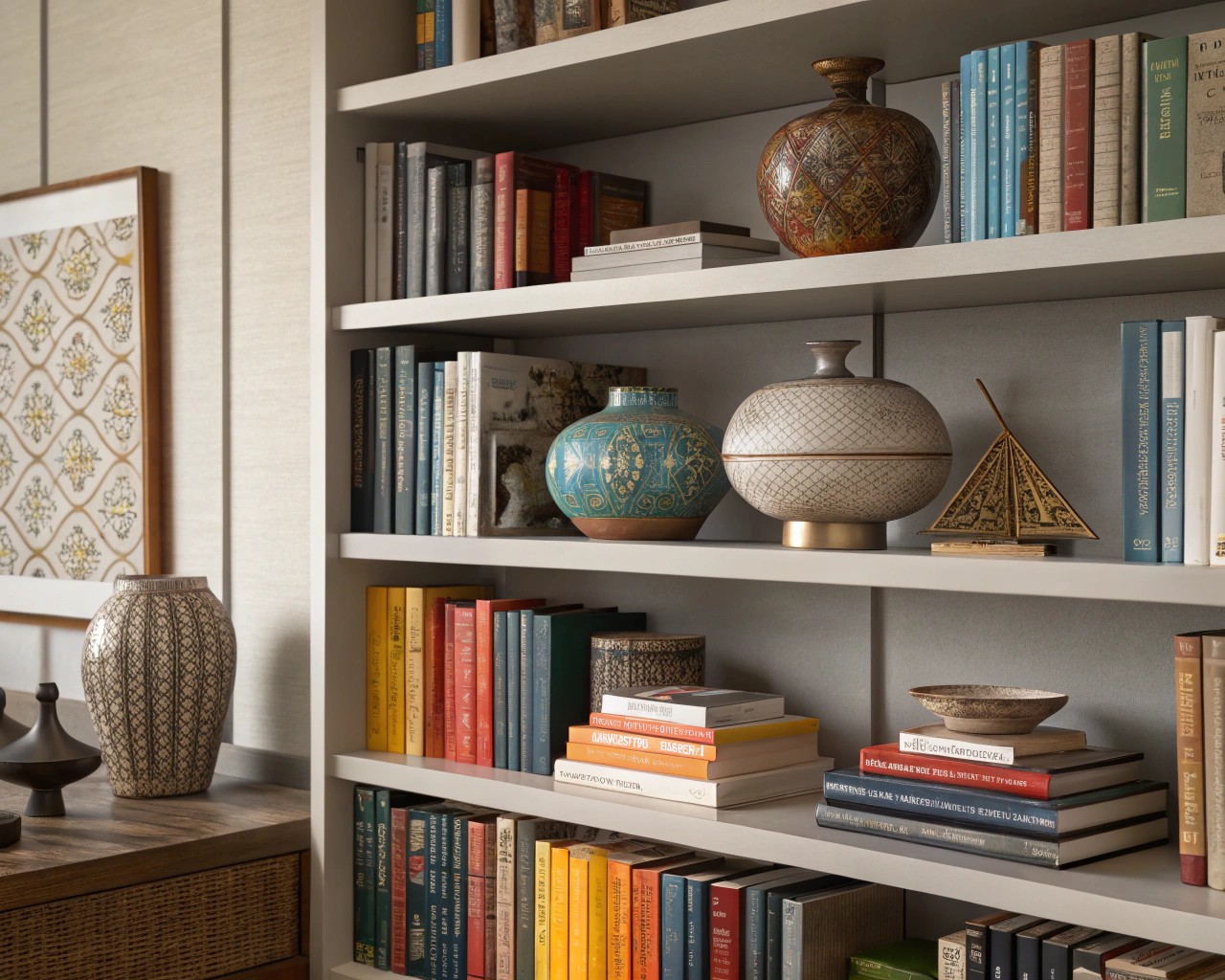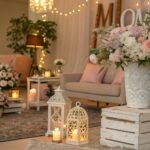The art of displaying collections beautifully while maintaining an uncluttered space is perhaps one of the most rewarding design challenges I encounter in my practice. Creating harmony between cherished possessions and the spaces that house them requires thoughtful balance—a curator’s approach rather than a collector’s tendency to simply acquire. This guide will help you transform potential chaos into elegant, meaningful displays that enhance your home rather than overwhelm it.
The Curator’s Mindset vs. The Collector’s Impulse

The fundamental difference between collecting and curating determines whether your precious items become showpieces or clutter. While collecting focuses on acquisition, curation emphasizes thoughtful selection and presentation.
Shifting Your Perspective
I’ve noticed working with clients that the most significant transformation happens when they adopt a curator’s mindset over a collector’s enthusiasm. The focus shifts from merely possessing items to appreciating their individual qualities. As one client memorably shared after we reorganized her vintage camera collection, “I finally feel like I can see each piece instead of just owning them.”
Museum curators don’t display every artifact they possess—they select pieces that create cohesive narratives or experiences. You can apply this same principle in your home:
- Ask purpose-driven questions about each item: Does it contribute something unique? Does it merit the space it occupies?
- Remove everything from a display area, then reintroduce items one by one, evaluating each piece’s contribution
- Establish collection parameters that help you make disciplined acquisition decisions
- Practice the “one in, one out” rule for mature collections
Case Study: The Book Collector’s Transformation

A client with multiple copies of favorite novels like Anne of Green Gables and Pride & Prejudice felt overwhelmed by her extensive book collection. We implemented a curator’s approach to regain control and appreciation:
- Sorted books by specific sub-categories rather than general groupings
- Selected the most meaningful or visually appealing edition of each title for display
- Created a dedicated “special editions” section for truly exceptional volumes
- Established a lending library system for duplicates among friends
The result was a more impactful collection where each carefully chosen book could be appreciated individually, free from the visual noise of overwhelming abundance.
Core Principles of Effective Collection Curation
Cohesion and Thematic Unity

Collections tell more powerful stories when unified by a connecting thread—whether color, era, material, or subject matter.
For instance, when working with a client’s diverse ceramic collection spanning multiple cultures and time periods, we found cohesion by grouping pieces based on color rather than origin. This unexpected organizing principle unified disparate items and created visually striking displays that complemented their home’s contemporary design.
Scale and Proportion
The relationship between your collections and the spaces they occupy significantly impacts visual harmony:
- Small objects need thoughtful grouping to prevent them from feeling insignificant in larger spaces
- Oversized items require adequate breathing room to prevent overwhelming smaller areas
- Creating visual mass through careful arrangement helps smaller collections hold their own
Negative Space: The Secret Ingredient
One of the most common mistakes I see is overcrowding. Every object needs breathing room—what designers call negative space—to be properly appreciated. This space isn’t empty; it’s an active part of the composition that allows the eye to rest and individual pieces to shine.
A key principle I emphasize with clients is that highlighting everything diminishes the impact of individual pieces. True curation understands this paradox: giving objects breathing room allows each one to stand out. By selectively highlighting fewer items with adequate space around them, you actually increase their individual and collective significance.
Space Assessment Framework
Before deciding how to display your collections, assess your available space objectively using this framework:
| Space Factor | Questions to Consider | Application Strategies |
|---|---|---|
| Size | Is the space expansive or intimate? | Larger spaces: larger groupings with more negative spaceSmaller spaces: more selective curation with focused impact |
| Light | How does natural and artificial light interact with the space? | Consider reflective qualities of collectionsProtect light-sensitive itemsUse lighting to highlight focal pieces |
| Architecture | What built-in features could enhance displays? | Utilize niches, alcoves, and architectural detailsConsider sight lines from primary viewing positions |
| Traffic | How do people move through the space? | Keep fragile items away from high-traffic pathsConsider visibility from seated vs. standing positions |
| Function | How is the space used daily? | Ensure collections don’t interfere with primary room functionsBalance display with practicality |
Effective Curation Methods
The Curated Clutter Method
This approach involves sorting items into specific mini-categories before making decisions about what to display. Unlike broad sorting (all books, all decorative objects), this method creates very specific groupings (art history books, ceramic vases) for more nuanced comparison.
To implement this method:
1. Select an area to declutter (a drawer, shelf, or display surface)
2. Remove everything and sort into highly specific categories
3. Compare items within each specific category
4. Select only the most meaningful or aesthetic pieces from each category
5. Return only these selected pieces to your display
Rotating Displays: The Museum Strategy

Not everything needs to be visible all the time. Creating a rotation schedule allows you to enjoy more of your collection while maintaining spatial harmony:
- Seasonal rotations align displays with the changing year
- Thematic rotations tell different stories with the same collection
- Preservation rotations protect sensitive items from excessive light exposure
A client with an extensive art print collection benefited greatly from implementing a quarterly rotation system, using archival portfolios for safe storage. This approach allowed her to enjoy different pieces throughout the year while preventing her apartment walls from feeling static or overcrowded.
Creating Effective Focal Points
Strategic focal points guide the eye and create visual hierarchy in your displays. Every grouping benefits from having a star—a larger, more colorful, or otherwise distinctive piece that anchors the collection.
In a recent project featuring a collection of vintage cameras, we designated one particularly unique model as the centerpiece. Arranging complementary pieces around it provided a visual anchor, bringing coherence and focus to the entire display.
Display Techniques That Maximize Impact
Grouping Strategies That Tell Stories
How you arrange items creates visual conversations between pieces:
- Symmetrical arrangements create formal, orderly displays ideal for traditional spaces
- Asymmetrical groupings feel more dynamic and casual, suitable for contemporary settings
- Massing similar objects creates visual impact through repetition and pattern
- Contrasting items highlight unique characteristics through juxtaposition
Layering and Depth
Creating visual depth prevents flat, static-feeling displays:
- Position some items further forward and others recessed
- Use varying heights within groupings
- Create background, middle ground, and foreground elements
- Consider the negative space between objects as part of the composition
Lighting: The Transformative Element

Thoughtful lighting transforms good displays into exceptional ones:
- Consider how natural light changes throughout the day
- Use directional accent lighting for key pieces
- Incorporate subtle ambient lighting for overall ambiance
- Install adjustable systems that can evolve with changing displays
For one client’s collection of mineral specimens, installing small, adjustable LED puck lights within the display cabinet made a significant difference. The focused lighting highlighted the intricate colors and crystalline structures, dramatically enhancing their visual appeal and contributing to the room’s evening ambiance.
Storage Solutions for Collection Management
Hidden Storage Strategies
Not everything needs to be on display. Creative hidden storage keeps collections accessible while preventing visual clutter:
- Behind-the-scenes inventory systems track items not currently displayed
- Archival storage systems protect valuable pieces when not in use
- Rotation schedules ensure regular refreshing of displays
Visible Storage as Design Elements
Sometimes storage itself becomes part of the display:
- Beautiful containers that complement your aesthetic
- Specialized cabinets designed for particular collections
- Custom solutions that highlight rather than hide organization
For a client who collected antique fountain pens, we designed a shallow drawer cabinet featuring glass tops. This solution effectively created a horizontal display case, protecting the delicate items while keeping them beautifully visible and organized.
Creative Storage Ideas by Collection Type

- Art prints and posters: Portfolio cases with labeled dividers
- Books: Floating shelves that display covers face-out
- Ceramics: Custom-built shelving with earthquake protection
- Jewelry: Vintage typesetter trays mounted vertically
- Textiles: Rolling storage in architectural flat files
- Vinyl records: Album art display systems with accessible storage
- Vintage clothing: Glass-fronted wardrobes that showcase while protecting
Case Studies: Curated Collections in Real Homes
The Historic Home Challenge
The owners of a 1920s Craftsman home faced the challenge of integrating multiple inherited family collections—including vintage cameras, antique quilts, and first-edition books. Their goal was to honor these heirlooms without overwhelming the historic character of their home.
Our approach involved:
1. Creating dedicated display areas suited to each collection type (e.g., cameras in the office, quilts in bedrooms).
2. Designing custom built-ins that offered a mix of open display shelves and concealed storage.
3. Selecting only the most significant or visually compelling pieces from each collection for prominent display.
4. Implementing a quarterly rotation system to refresh the displays seasonally.
This strategy successfully maintained the home’s historic integrity while celebrating family heritage through thoughtfully curated vignettes. The displays complemented daily life rather than competing with it.
The Minimalist Collector Solution
A couple favoring minimalist aesthetics, yet passionate about collecting mid-century ceramics, needed a way to reconcile their love for clean spaces with their growing collection.
Our strategy focused on concentration and control:
1. We designed a single, dramatic display wall in the dining area, equipped with museum-quality lighting.
2. Ample negative space was incorporated within the display to emphasize each piece.
3. A strict “one in, one out” policy was implemented for any new acquisitions.
4. A simple, neutral backdrop ensured the collection remained the undisputed focus.
This focused approach allowed the couple to fully appreciate their cherished ceramics while preserving the minimalist feel throughout the rest of their home.
The Small Space Maximalist
A client residing in a compact 650-square-foot apartment aimed to showcase her eclectic collections without compromising the apartment’s functionality.
Our space-saving solution included:
1. Utilizing vertical space extensively with floating shelves installed high on the walls.
2. Creating a flexible gallery wall system with adjustable components, facilitating easy rotation.
3. Designating specific “display zones” to prevent collections from sprawling uncontrollably.
4. Incorporating dual-purpose furniture pieces that featured built-in display areas.
The outcome was a space that felt personally curated and expressive, yet maintained essential functionality despite the limited square footage.
Maintenance and Evolution Systems
Keeping Collections Fresh
Periodic rearrangement keeps collections feeling fresh and allows you to see familiar pieces with new eyes:
- Set calendar reminders for regular display refreshes
- Document successful arrangements with photos for future reference
- Consider seasonal themes that provide natural refresh points
Collection Maintenance Schedule
| Timeframe | Maintenance Task | Purpose |
|---|---|---|
| Weekly | Light dusting and minor adjustments | Prevents accumulation of dust and maintains arrangement integrity |
| Monthly | Photograph current arrangements | Creates record of successful displays for future reference |
| Quarterly | Rotate displayed items | Keeps collections fresh and protects sensitive items from light exposure |
| Biannually | Deep clean and condition | Maintains condition of both displayed and stored items |
| Annually | Evaluate entire collection | Consider additions, subtractions, and new arrangement strategies |





















